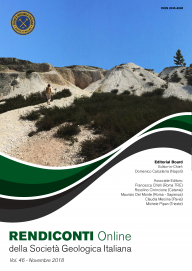
Assessing landscape changes associated to anthropic disturbances by means of the application of Structure from Motion photogrammetry using historical aerial imagery
Manel Llena (1), Marco Cavalli (2), Damià Vericat (1,3) & Stefano Crema (2,4)
(1) Fluvial Dynamics Research Group (RIUS), University of Lleida, Av. Alcalde Rovira Roure 191, 25198 Lleida, Spain.
(2) Hydrogeomorphology Research Group, National Research Council, Research Institute for Geo-Hydrological Protection (CNR-IRPI), Corso Stati Uniti 4, 35127,
Padova, Italy.
(3) Forest Sciences Centre of Catalonia (CTFC), 25280 Solsona, Spain.
(4) Dpt. Land Environment Agriculture and Forestry, University of Padova, Via dell'Università 16, 35020, Legnaro, Italy.
Corresponding author e-mail: mllena@macs.udl.cat.
Volume: 46/2018
Pages: 74-81
Abstract
In this paper we present a methodological workflow to obtain planimetric and topographic data from historical aerial photos using photogrammetric methods through Structure from Motion (SfM) and Multi-View Stereo (MVS) algorithms. This methodology is applied in two case studies located in the Upper Cinca River catchment (Southern Pyrenees). These sites have suffered a series of direct anthropogenic disturbances that have modified landscape topography. Specifically,
topographic changes associated with the construction of a road and the extraction of materials from a pit quarry have been analysed. The resultant products extracted by the application of SfM-MVS are orthomosaics with a root mean square error (RMSE) between 0.5 and 1 m, and points clouds (topography) with a RMSE between 1 and 2 m. The topography before and after each of the impacts was compared with the objective to analyse the changes attributed to these disturbances. A simple minimum Level of Detection (minLoD) was estimated based on the RMSEs in order to distinguish potential real changes from those due to the noise ascribable to the uncertainty of the topographic data sets. The significance of both impacts is relevant
in terms of topographic changes (from -20 to +15 m). The dominant topographic change (in extension) in the case of the road construction (51% of the surface) is extraction (i.e. erosion). In the case of the pit quarry, the dominant process is deposition (i.e. sedimentation; 27% of the area). The extension below the minLoD is around the 23% and 48%, respectively, indicating that the magnitude of the changes
is substantially higher in the case of the road construction. In both cases the net volume is negative (-913,710 and -16,197 m3 in the case of the road and the quarry, respectively), that show the differences in terms of the extension of the processes and their magnitude in each case study. Finally, both impacts had a direct effect on landscape morphometry (e.g. changes in the slope and flow direction). The developed approach provides an opportunity to analysed and quantify landscape changes that may help to improve our understanding of the long-term evolution of the transfer of water and sediment through landscapes.
Keywords
aerial photographs, Structure from Motion, land use changes, topographic changes, road construction, pit quarry.
Get Full Text